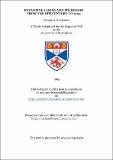Byzantine Larisa and its region from the 6th century to 1204
Abstract
The mediaeval town of Larisa and its immediate vicinity -the most important part of Thessaly- in central Greece have been generally viewed as one of the most remote and underdeveloped areas within the Byzantine Empire. By the examination of the sources under a new light and the exploitation of new archaeological evidence the present thesis challenges this traditional view and attempts to highlight the key role which Larisa played as one of the most prominent administrative and ecclesiastical centres in Greece. Chapter One deals with the invasions of the Slavs in the Thessalian territory during the 6th-7th centuries, their subsequent settlements and their final absorption in the Byzantine state through their hellenization and Christianisation. Chapter Two examines the changes within local society after the passing of the Dark Ages, and considers the fate of the town during the temporary Arab threat, and the invasions of Symeon and Samuel in the course of the 10th century. Chapter Three focuses on the important administrative changes, the architectural renaissance in the region of Ossa, the Thessalian revolt of 1066 and the presence of the Vlachs as a disdnct ethnic group. Chapter Four gives the clearest possible account of Alexios' I campaign in 1082 with a view to relieving Larisa from the Norman pressure. Chapter Five confirms in the region of Larisa the economic prosperity attested throughout the empire in the first three quarters of the 12th century, analyses the local administrative structures and studies the circumstances under which Larisa passed into Latin hands. Finally, Chapter Six provides a clear view of the ecclesiastical organisation of the area, attests the Bogomil threat during the 12th century, evaluates the important role of St. Achilleios' cult and summarises the monastic presence in the mountain of Kellia.
Type
Thesis, MPhil Master of Philosophy
Collections
Items in the St Andrews Research Repository are protected by copyright, with all rights reserved, unless otherwise indicated.

